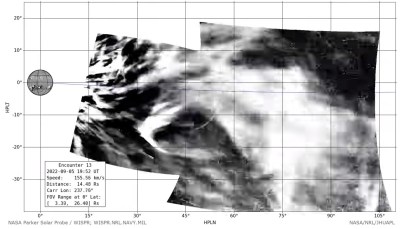Good news, bad news for Sun watchers this week, as our star launched a solar flare even bigger than the one back in May that gave us an amazing display of aurora that dipped down into pretty low latitudes. This was a big one; where the earlier outburst was only an X8.9 class, the one on July 23 was X14. That sure sounds powerful, but to put some numbers to it, the lower end of the X-class exceeds 10-4 W/m2 of soft X-rays. Numbers within the class designate a linear increase in power, so X2 is twice as powerful as X1. That means the recent X14 flare was about five times as powerful as the May flare that put on such a nice show for us. Of course, this all pales in comparison to the strongest flare of all time, a 2003 whopper that pegged the needle on satellite sensors at X17 but was later estimated at X45.
sun36 Articles
Solar Dynamics Observatory: Our Solar Early Warning System
Ever since the beginning of the Space Age, the inner planets and the Earth-Moon system have received the lion’s share of attention. That makes sense; it’s a whole lot easier to get to the Moon, or even to Mars, than it is to get to Saturn or Neptune. And so our probes have mostly plied the relatively cozy confines inside the asteroid belt, visiting every world within them and sometimes landing on the surface and making a few holes or even leaving some footprints.
But there’s still one place within this warm and familiar neighborhood that remains mysterious and relatively unvisited: the Sun. That seems strange, since our star is the source of all energy for our world and the system in general, and its constant emissions across the electromagnetic spectrum and its occasional physical outbursts are literally a matter of life and death for us. When the Sun sneezes, we can get sick, and it has the potential to be far worse than just a cold.
While we’ve had a succession of satellites over the last decades that have specialized in watching the Sun, it’s not the easiest celestial body to observe. Most spacecraft go to great lengths to avoid the Sun’s abuse, and building anything to withstand the lashing our star can dish out is a tough task. But there’s one satellite that takes everything that the Sun dishes out and turns it into a near-constant stream of high-quality data, and it’s been doing it for almost 15 years now. The Solar Dynamics Observatory, or SDO, has also provided stunning images of the Sun, like this CGI-like sequence of a failed solar eruption. Images like that have captured imaginations during this surprisingly active solar cycle, and emphasized the importance of SDO in our solar early warning system.
Continue reading “Solar Dynamics Observatory: Our Solar Early Warning System”
Enjoy Totality Every Day With This Personal Eclipse Generator
There have been a couple of high-profile solar eclipses lately, but like us, you probably missed the news of the one that passed over Munich in 2019. And every day since then, in fact, unless you were sitting in a particular spot: the couch of one [Bernd Kraus], who has his very own personal eclipse generator.
We’ll attempt to explain. Living in an apartment with a gorgeous western view of Munich is not without its cons, chief among which is the unobstructed exposure to the setting sun. Where most people would opt for a window treatment of some sort to mitigate this, [Bernd] felt that blotting out the entire view was a heavy-handed solution to the problem. His solution is a window-mounted X-Y gantry that dangles a cutout of the moon in just the right place to blot out the sun. An Arduino uses the time and date to calculate the position of the sun as it traverses the expansive window and moves the stepper motors to keep the moon casting its shadow in just the right place: on his face as he sits in his favorite spot on the couch.
There are a couple of time-lapse sequences in the video below, as well as a few shots of the hardware. We know this isn’t an actual coronagraph, but the effect is pretty cool, and does resemble an eclipse, at least in spirit. And it goes without saying that we applaud the unnecessary complexity embodied by this solution.
Continue reading “Enjoy Totality Every Day With This Personal Eclipse Generator”
Filming The Eclipse From 80,000 Feet
Watching an eclipse from the ground is pretty fun. Depending on where you live, you might even get a decent view. But what if you wanted a truly unique vantage point? You could replicate the work of [Tarik Agcayazi] and [kemfic], who set about filming the recent eclipse from an altitude of 80,000 feet.

The duo didn’t rent a high-performance aircraft from the US military. Instead, they relied on a high-altitude balloon carrying a glider with a camera payload. The idea was for the balloon to go up, and have the camera capture the eclipse. Then, it would be released so that it could glide back home in controlled flight. However, time constraints made that too hard. Instead, they simplified to a parachute recovery method.
The project video covers the development process, the balloon launch itself, and of course, the filming of the eclipse. High altitude balloon launches are stressful enough, but having a short eclipse as a target made everything even more difficult. But that just makes things more exciting!
The project builds on earlier work from the duo that we discussed back in 2017.
The Sunspots Are Coming (Again)
There are a bunch of ways to estimate the age of a radio amateur, by the letters in their callsign, by their preferred choice of homebrewing technology, or sometimes by their operating style. One that perhaps doesn’t immediately come to mind is to count how many solar cycles they remember, and since the current cycle 25 is my fourth I guess I’ve seen a few. Cycle 25 is so far shaping up to be quite an active one especially of late, which popular media are describing as bombarding us with flares from a “sunspot archipelago” and the more measured tones of spaceweather.com giving us warning of X-class flares heading in our direction, today!

As the technology for solar observation has increased in sophistication and the Internet has allowed anyone to follow the events above us as they unfold, the awareness of solar phenomena has shifted away from the relatively small numbers of astronomers and radio amateurs who would once have been eagerly awaiting a solar cycle to a wider audience. Ever since a particularly severe event in March 1989 during cycle 22 caused disruptions including the blackout of a significant part of Canada it’s been a periodic topic of mild doom in slow news moments. But what lies behind the reports of solar activity? Perhaps it’s time to take a look.
The solar cycle refers to the 11-year period of solar activity from a maximum of observed sunspots through a minimum to a new maximum. The sunspots are the visible evidence of the solar magnetic field changing its polarity, and appear as darker areas where there is a greater strength of magnetic flux in the sun’s photosphere. We refer to solar cycles by number with solar cycle 1 occurring in 1755 because that year represents the earliest cycle which can be found in modern astronomical observation data, but previous cycles have been deduced over millennia through dendrochronology, sediment analysis, isotope observations, and other methods. Continue reading “The Sunspots Are Coming (Again)”
NASA’s Parker Probe Gets Front Row Seat To CME
A little over a year ago, and about 150 million kilometers (93 million miles) from where you’re currently reading this, NASA’s Parker Solar Probe quietly made history by safely flying through one of the most powerful coronal mass ejections (CMEs) ever recorded. Now that researchers have had time to review the data, amateur space nerds like ourselves are finally getting details about the probe’s fiery flight.
Launched in August 2018, the Parker Solar Probe was built to get up close and personal with our local star. Just two months after liftoff, it had already beaten the record for closest approach to the Sun by a spacecraft. The probe, with its distinctive solar shield, has come within 8.5 million kilometers (5.3 million miles) of its surface, a record that it’s set to break as its highly elliptical orbit tightens.

As clearly visible in the video below, the Parker probe flew directly into the erupting CME on September the 5th of 2022, and didn’t get fully clear of the plasma for a few days. During that time, researchers say it observed something that had previously only been theorized — the interaction between a CME and the swirling dust and debris that fills our solar system.
According to the Johns Hopkins Applied Physics Laboratory (APL), the blast that Parker flew through managed to displace this slurry of cosmic bric a brac out to approximately 9.6 million km (6 million miles), though the void it created was nearly instantly refilled. The researchers say that better understanding how a CME propagates through the interplanetary medium could help us better predict and track potentially dangerous space weather.
It’s been a busy year for the Parker Solar Probe. Back in June it announced that data from the craft was improving our understanding of high-speed solar winds. With the spacecraft set to move closer and closer to the Sun over the next two years, we’re willing to bet this isn’t the last discovery to come from this fascinating mission.
Continue reading “NASA’s Parker Probe Gets Front Row Seat To CME”
Chandelier Mimics The Solar Analemma
The solar analemma is the shape the sun traces out when photographed each day at the same time and same location for a whole year – but you probably knew that already. [makendo] decided to use this skewed figure-eight shape as the inspiration for a chandelier, and the results are stunning.
A laser cutter was used to cut out segments of the analemma shape in plywood, such that they could slot together into the full form. These were then glued together on to a plywood sheet as a template to cut out the full-size form in a single piece. Some laminate edging was then added and the entire thing was given a coat of black gloss paint. String lights were cut up to provide the many globe fittings required, and installed on the back of the chandelier.
[makendo] notes that with a full 51 bulbs in the chandelier, it’s way too bright for most dining room settings. A dimmer is thus used to tone down the output to reduce eyestrain at mealtimes. It’s a fun build, and we’ve always loved light fixtures that are inspired by astronomy. If you like the moon more than the sun, though, there’s a build for you too!


















